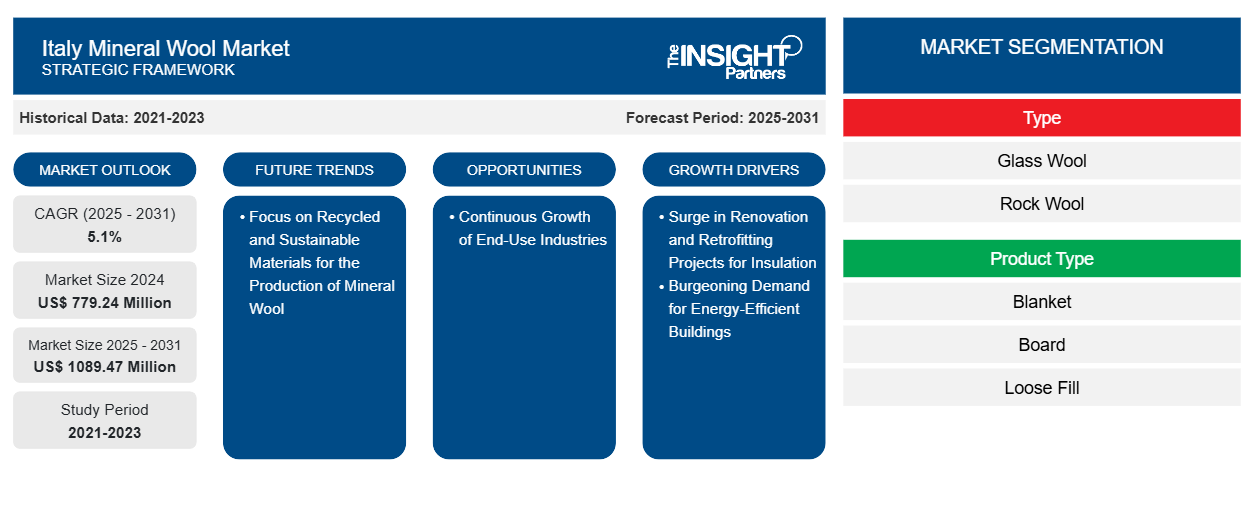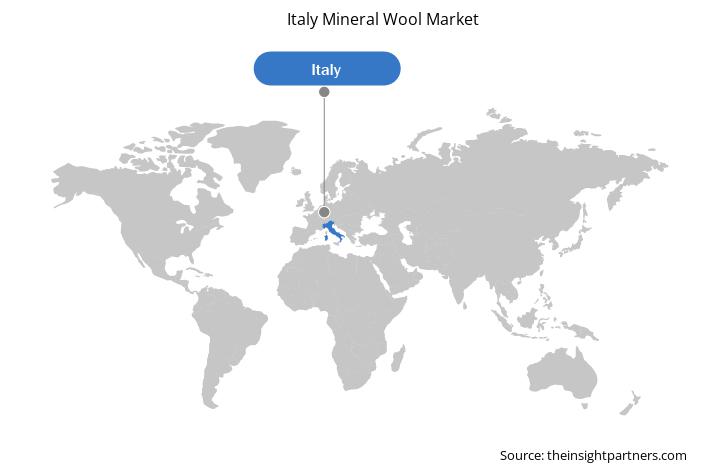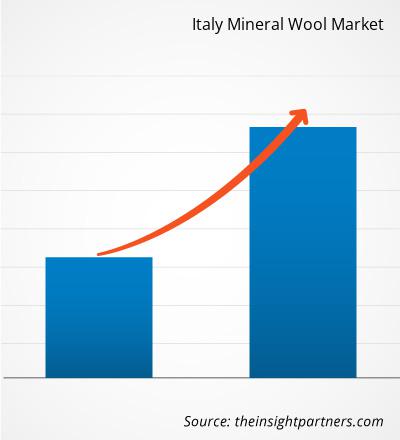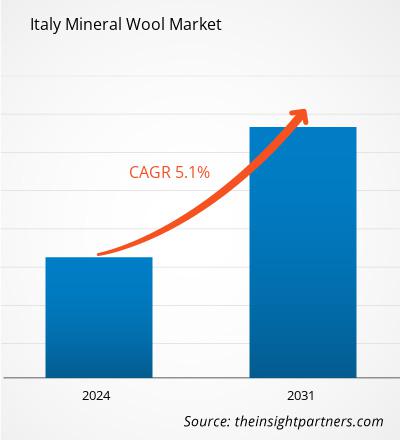Der italienische Mineralwollmarkt wurde im Jahr 2024 auf 779,24 Millionen US-Dollar geschätzt und soll bis 2031 1089,47 Millionen US-Dollar erreichen. Für den Zeitraum 2025–2031 wird eine durchschnittliche jährliche Wachstumsrate (CAGR) von 5,1 % erwartet. Der Fokus auf recycelte und nachhaltige Materialien zur Herstellung von Mineralwolle dürfte im Prognosezeitraum neue Trends auf dem Markt mit sich bringen.
Italien Mineralwolleanalyse
Die italienische Regierung hat im Laufe der Jahre mehrere Programme zur Verbesserung der Energieeffizienz bestehender Gebäude genehmigt und finanziert. Im Rahmen des Programms „Conto Termico“ stellt die Regierung jährlich rund 400 Millionen US-Dollar für private Unternehmen und rund 500 Millionen US-Dollar für öffentliche Unternehmen bereit. Öffentliche Unternehmen nutzen dieses Programm, um Projekte zur Verbesserung der Dämmwirkung der Gebäudehülle durch Dämmung von Dächern und Wänden sowie den Einbau von Sonnenschutz umzusetzen. Anreize zur Verbesserung der Dämmwirkung machen 40 % der Gesamtausgaben für die Sanierung bestehender Gebäude aus.
Mineralwolle in Italien – Übersicht
Mineralwolle ist ein faseriges Material, das durch Ziehen oder Spinnen geschmolzener Mineral- oder Gesteinsmaterialien wie Keramik und Schlacke hergestellt wird. Neben seiner Nichtbrennbarkeit machen seine Eigenschaften wie Schalldämmung, Wärmeleitfähigkeit und Haltbarkeit ihn zu einem idealen Dämmstoff in verschiedenen Branchen, darunter Bauwesen, Automobilindustrie, Öl- und Gasindustrie, Energieerzeugung sowie Luft- und Raumfahrt. Fördernde staatliche Maßnahmen wie Conto Termico fördern die Renovierung und Nachrüstung bestehender Gebäude durch den Einsatz von Dämmstoffen, um Brände zu verhindern und den Energieverbrauch in Gebäuden zu senken. Dies kommt wiederum dem italienischen Mineralwollmarkt zugute.
Passen Sie diesen Bericht Ihren Anforderungen an
Sie erhalten kostenlos Anpassungen an jedem Bericht, einschließlich Teilen dieses Berichts oder einer Analyse auf Länderebene, eines Excel-Datenpakets sowie tolle Angebote und Rabatte für Start-ups und Universitäten
Italienischer Mineralwollemarkt:

- Informieren Sie sich über die wichtigsten Markttrends in diesem Bericht.Dieses KOSTENLOSE Beispiel umfasst eine Datenanalyse, die von Markttrends bis hin zu Schätzungen und Prognosen reicht.
Treiber und Chancen für Mineralwolle in Italien
Steigende Nachfrage nach energieeffizienten Gebäuden treibt Marktwachstum an
Laut der Internationalen Energiebehörde (IEA) wird der Gebäudesektor in Italien bis 2030 voraussichtlich 60 % der jährlichen Endenergieeinsparungen beitragen. Die Nachfrage nach energieeffizienten Gebäuden, die den Vorschriften und Richtlinien der italienischen Regierung entsprechen, steigt. Der italienische Nationale Integrierte Plan für Energie und Klima (PNIEC), der die EU-Verordnung Nr. 1999/2018 zum europäischen Klimarahmen umsetzt, hat das Ziel festgelegt, den Primärenergieverbrauch bis 2030 um 43 % und den Endenergieverbrauch um 39,7 % zu senken und bis 2050 Netto-Null-Emissionen zu erreichen.PNIEC), enacting EU Regulation No. 1999/2018 on the European climate framework, has established a target of decreasing the primary
Kontinuierliches Wachstum der Endverbrauchsindustrien schafft Marktchancen
Mineralwolle findet breite Anwendung in verschiedenen Branchen, darunter Automobilindustrie, Öl- und Gasindustrie, Energieerzeugung sowie Luft- und Raumfahrt. In der Öl- und Gasindustrie und anderen Branchen wird Mineralwolle zum Schutz von Rohrleitungen, Leitungen und Strukturen vor Wärmeübertragung im System eingesetzt. In Branchen wie der Automobilindustrie, Luft- und Raumfahrt und Energieerzeugung verhindert Mineralwolle Überhitzung und reduziert Lärmbelästigung.
Die strategische geografische Lage in Europa und im Mittelmeerraum macht Italien zu einem idealen Markt für ausländische Investitionen in Endverbrauchsindustrien wie Automobil, Öl und Gas, Bauwesen , Luft- und Raumfahrt sowie Energieerzeugung. Laut der International Trade Administration ist Italien die zweitgrößte Produktionsnation in Europa. Das Land ist ein bedeutender Hersteller von Kraftfahrzeugen. Der Absatz von leichten Nutzfahrzeugen erreichte 2022 160.830 Einheiten und stieg 2023 um weitere 8,8 %. Der gleichen Quelle zufolge ist die Öl- und Gasindustrie eine der bedeutendsten Industrien des Landes. Erdgas und Öl tragen 38 % bzw. 37 % zur gesamten Energieversorgung bei. Laut der International Trade Administration hat Italien aufgrund gestiegener Investitionen auch die zwölftgrößte Bauindustrie der Welt. Nach Angaben der National Association of Building Contractors stiegen die Investitionen in der Bauindustrie im Jahr 2022 im Vergleich zum Vorjahr um 17,6 % und erreichten 176,2 Milliarden US-Dollar. Das kontinuierliche Wachstum dieser Branchen dürfte in den kommenden Jahren Chancen für das Wachstum des italienischen Mineralwollemarktes schaffen.
Italien Mineralwolle Aktie Segmentierungsanalyse
Die wichtigsten Segmente, die zur Ableitung der Marktanalyse für Mineralwolle in Italien beigetragen haben, sind Typ, Produkttyp und Endverbrauchsbranche.
- Der italienische Mineralwollmarkt ist nach Typ in Glaswolle, Steinwolle und andere unterteilt. Das Segment Glaswolle hatte im Jahr 2024 den größten Marktanteil.
- Der italienische Mineralwollmarkt ist nach Produkttypen in Decken, Platten, Schüttungen, Sprays und andere Produkte unterteilt. Das Plattensegment hatte im Jahr 2024 den größten Marktanteil.
- Nach Endverbrauchsbranchen ist der italienische Mineralwollemarkt in die Branchen Bauwesen, Automobilindustrie, Luft- und Raumfahrt, Elektronik und Elektrik, Öl und Gas, Stromerzeugung und andere unterteilt. Das Bauwesen hielt im Jahr 2024 den größten Marktanteil.
Italien Mineralwolle Aktienanalyse nach Land
Die Nachfrage nach Mineralwolle wächst rasant. Das Wachstum im Baugewerbe ist der wichtigste Wachstumsfaktor für den Mineralwollemarkt in Italien. Aufgrund des steigenden Umweltbewusstseins legt Italien zudem eine starke Vorliebe für nachhaltige Materialien an den Tag. Dies hat dazu geführt, dass mehrere Mineralwollehersteller Mineralwolle aus nachhaltigen Materialien wie recyceltem Glas und Flaschen sowie Baustellenabfällen auf den Markt bringen und damit den strengen gesetzlichen Vorschriften auf dem italienischen Markt entsprechen.
Regionale Einblicke in den italienischen Mineralwollemarkt
Die Analysten von Insight Partners haben die regionalen Trends und Faktoren, die den italienischen Mineralwollemarkt im Prognosezeitraum beeinflussen, ausführlich erläutert. Dieser Abschnitt behandelt auch die Marktsegmente und die geografische Lage in Italien in Nordamerika, Europa, Asien-Pazifik, dem Nahen Osten und Afrika sowie Süd- und Mittelamerika.

- Erhalten Sie regionale Daten zum italienischen Mineralwollemarkt
Umfang des Mineralwolle-Marktberichts in Italien
| Berichtsattribut | Details |
|---|---|
| Marktgröße im Jahr 2024 | 779,24 Millionen US-Dollar |
| Marktgröße bis 2031 | 1089,47 Millionen US-Dollar |
| Globale CAGR (2025 – 2031) | 5,1 % |
| Historische Daten | 2021-2023 |
| Prognosezeitraum | 2025–2031 |
| Abgedeckte Segmente | Nach Typ
|
| Abgedeckte Regionen und Länder | Italien
|
| Marktführer und wichtige Unternehmensprofile |
|
Marktteilnehmerdichte für Mineralwolle in Italien: Auswirkungen auf die Geschäftsdynamik
Der italienische Mineralwollemarkt wächst rasant. Die steigende Endverbrauchernachfrage ist auf Faktoren wie veränderte Verbraucherpräferenzen, technologische Fortschritte und ein stärkeres Bewusstsein für die Produktvorteile zurückzuführen. Mit der steigenden Nachfrage erweitern Unternehmen ihr Angebot, entwickeln Innovationen, um den Verbraucherbedürfnissen gerecht zu werden, und nutzen neue Trends, was das Marktwachstum weiter ankurbelt.
Die Marktteilnehmerdichte beschreibt die Verteilung der in einem bestimmten Markt oder einer bestimmten Branche tätigen Unternehmen. Sie gibt an, wie viele Wettbewerber (Marktteilnehmer) in einem bestimmten Marktraum im Verhältnis zu dessen Größe oder Gesamtmarktwert präsent sind.
Die wichtigsten Unternehmen auf dem italienischen Mineralwollemarkt sind:
- Saint-Gobain
- Owens Corning
- Knauf Isolation
- Eurofibre Srl
- FIBRAN SA
- Rockwool-Gruppe
Haftungsausschluss : Die oben aufgeführten Unternehmen sind nicht in einer bestimmten Reihenfolge aufgeführt.

- Überblick über die wichtigsten Akteure auf dem italienischen Mineralwollemarkt
Neuigkeiten und aktuelle Entwicklungen zu Mineralwolle in Italien
Der italienische Mineralwollemarkt wird durch die Erhebung qualitativer und quantitativer Daten aus Primär- und Sekundärforschung bewertet, die wichtige Unternehmensveröffentlichungen, Verbandsdaten und Datenbanken umfasst.
Die Knauf Gruppe und Texnopark haben eine gemeinsame Vereinbarung bekannt gegeben: Knauf übernimmt das Dämmstoffgeschäft mit Steinwolle von Texnopark. Die Akquisition umfasst ein neues Werk in Taschkent, Usbekistan, das mit fortschrittlicher Elektroschmelztechnologie ausgestattet ist und so eine CO2-arme Produktion ermöglicht. (Knauf Insulation, Unternehmensnachrichten, Dezember 2024)
Saint-Gobain Indien plant im Rahmen einer neuen Investitionsphase die Verdoppelung seiner Produktionskapazitäten für Glas- und Steinwolledämmstoffe und strebt bis 2032 einen geschäftsübergreifenden Umsatz von 4,3 Milliarden US-Dollar an. (Saint-Gobain, Unternehmensnachrichten, Juni 2024)
Berichtsumfang und Ergebnisse zu Mineralwolle in Italien
Der Bericht „Marktgröße und Prognose für Mineralwolle in Italien (2021–2031)“ bietet eine detaillierte Analyse des Marktes, die die folgenden Bereiche abdeckt:
- Markttrends und Prognosen für Mineralwolle in Italien für alle wichtigen Marktsegmente, die im Rahmen des Projekts abgedeckt sind
- Markttrends für Mineralwolle in Italien sowie Marktdynamiken wie Treiber, Beschränkungen und wichtige Chancen
- Detaillierte Porter's Five Forces und SWOT-Analyse
- Analyse des italienischen Mineralwollemarkts mit Blick auf wichtige Markttrends, Länderrahmen, wichtige Akteure, Vorschriften und aktuelle Marktentwicklungen.
- Branchenlandschaft und Wettbewerbsanalyse mit Marktkonzentration, Heatmap-Analyse, prominenten Akteuren und jüngsten Entwicklungen für den italienischen Mineralwollemarkt
- Detaillierte Firmenprofile
- Historische Analyse (2 Jahre), Basisjahr, Prognose (7 Jahre) mit CAGR
- PEST- und SWOT-Analyse
- Marktgröße Wert/Volumen – Global, Regional, Land
- Branche und Wettbewerbsumfeld
- Excel-Datensatz


- Hydrogen Compressors Market
- Industrial Inkjet Printers Market
- Enzymatic DNA Synthesis Market
- Drain Cleaning Equipment Market
- Sexual Wellness Market
- Portable Power Station Market
- Data Annotation Tools Market
- Batter and Breader Premixes Market
- Print Management Software Market
- Artificial Intelligence in Healthcare Diagnosis Market

Report Coverage
Revenue forecast, Company Analysis, Industry landscape, Growth factors, and Trends

Segment Covered
This text is related
to segments covered.

Regional Scope
North America, Europe, Asia Pacific, Middle East & Africa, South & Central America

Country Scope
This text is related
to country scope.
Häufig gestellte Fragen
Saint-Gobain; Owens Corning; Knauf Insulation; Eurofibre S.r.l; FIBRAN S.A.; Rockwool Group; Luyang Energy-Saving Materials Co., Ltd; PETRALANA S.A.; URSA Insulation; and NICHIAS Corporation are among the key players operating in the market.
Focus on recycled and sustainable materials for the production of mineral wool is expected to emerge as a future trend in the market during the forecast period.
The surge in renovation and retrofitting projects for insulation and the burgeoning demand for energy-efficient buildings drive the market growth.
The market is expected to register a CAGR of 4.6% during 2025–2031.
Trends and growth analysis reports related to Chemicals and Materials : READ MORE..
The List of Companies - Italy Mineral Wool Market
- Saint-Gobain
- Owens Corning
- Knauf Insulation
- Eurofibre S.r.l
- FIBRAN S.A.
- Rockwool Group
- Luyang Energy-Saving Materials Co., Ltd
- PETRALANA S.A.
- URSA Insulation
- NICHIAS Corporation
The Insight Partners performs research in 4 major stages: Data Collection & Secondary Research, Primary Research, Data Analysis and Data Triangulation & Final Review.
- Data Collection and Secondary Research:
As a market research and consulting firm operating from a decade, we have published and advised several client across the globe. First step for any study will start with an assessment of currently available data and insights from existing reports. Further, historical and current market information is collected from Investor Presentations, Annual Reports, SEC Filings, etc., and other information related to company’s performance and market positioning are gathered from Paid Databases (Factiva, Hoovers, and Reuters) and various other publications available in public domain.
Several associations trade associates, technical forums, institutes, societies and organization are accessed to gain technical as well as market related insights through their publications such as research papers, blogs and press releases related to the studies are referred to get cues about the market. Further, white papers, journals, magazines, and other news articles published in last 3 years are scrutinized and analyzed to understand the current market trends.
- Primary Research:
The primarily interview analysis comprise of data obtained from industry participants interview and answers to survey questions gathered by in-house primary team.
For primary research, interviews are conducted with industry experts/CEOs/Marketing Managers/VPs/Subject Matter Experts from both demand and supply side to get a 360-degree view of the market. The primary team conducts several interviews based on the complexity of the markets to understand the various market trends and dynamics which makes research more credible and precise.
A typical research interview fulfils the following functions:
- Provides first-hand information on the market size, market trends, growth trends, competitive landscape, and outlook
- Validates and strengthens in-house secondary research findings
- Develops the analysis team’s expertise and market understanding
Primary research involves email interactions and telephone interviews for each market, category, segment, and sub-segment across geographies. The participants who typically take part in such a process include, but are not limited to:
- Industry participants: VPs, business development managers, market intelligence managers and national sales managers
- Outside experts: Valuation experts, research analysts and key opinion leaders specializing in the electronics and semiconductor industry.
Below is the breakup of our primary respondents by company, designation, and region:

Once we receive the confirmation from primary research sources or primary respondents, we finalize the base year market estimation and forecast the data as per the macroeconomic and microeconomic factors assessed during data collection.
- Data Analysis:
Once data is validated through both secondary as well as primary respondents, we finalize the market estimations by hypothesis formulation and factor analysis at regional and country level.
- Macro-Economic Factor Analysis:
We analyse macroeconomic indicators such the gross domestic product (GDP), increase in the demand for goods and services across industries, technological advancement, regional economic growth, governmental policies, the influence of COVID-19, PEST analysis, and other aspects. This analysis aids in setting benchmarks for various nations/regions and approximating market splits. Additionally, the general trend of the aforementioned components aid in determining the market's development possibilities.
- Country Level Data:
Various factors that are especially aligned to the country are taken into account to determine the market size for a certain area and country, including the presence of vendors, such as headquarters and offices, the country's GDP, demand patterns, and industry growth. To comprehend the market dynamics for the nation, a number of growth variables, inhibitors, application areas, and current market trends are researched. The aforementioned elements aid in determining the country's overall market's growth potential.
- Company Profile:
The “Table of Contents” is formulated by listing and analyzing more than 25 - 30 companies operating in the market ecosystem across geographies. However, we profile only 10 companies as a standard practice in our syndicate reports. These 10 companies comprise leading, emerging, and regional players. Nonetheless, our analysis is not restricted to the 10 listed companies, we also analyze other companies present in the market to develop a holistic view and understand the prevailing trends. The “Company Profiles” section in the report covers key facts, business description, products & services, financial information, SWOT analysis, and key developments. The financial information presented is extracted from the annual reports and official documents of the publicly listed companies. Upon collecting the information for the sections of respective companies, we verify them via various primary sources and then compile the data in respective company profiles. The company level information helps us in deriving the base number as well as in forecasting the market size.
- Developing Base Number:
Aggregation of sales statistics (2020-2022) and macro-economic factor, and other secondary and primary research insights are utilized to arrive at base number and related market shares for 2022. The data gaps are identified in this step and relevant market data is analyzed, collected from paid primary interviews or databases. On finalizing the base year market size, forecasts are developed on the basis of macro-economic, industry and market growth factors and company level analysis.
- Data Triangulation and Final Review:
The market findings and base year market size calculations are validated from supply as well as demand side. Demand side validations are based on macro-economic factor analysis and benchmarks for respective regions and countries. In case of supply side validations, revenues of major companies are estimated (in case not available) based on industry benchmark, approximate number of employees, product portfolio, and primary interviews revenues are gathered. Further revenue from target product/service segment is assessed to avoid overshooting of market statistics. In case of heavy deviations between supply and demand side values, all thes steps are repeated to achieve synchronization.
We follow an iterative model, wherein we share our research findings with Subject Matter Experts (SME’s) and Key Opinion Leaders (KOLs) until consensus view of the market is not formulated – this model negates any drastic deviation in the opinions of experts. Only validated and universally acceptable research findings are quoted in our reports.
We have important check points that we use to validate our research findings – which we call – data triangulation, where we validate the information, we generate from secondary sources with primary interviews and then we re-validate with our internal data bases and Subject matter experts. This comprehensive model enables us to deliver high quality, reliable data in shortest possible time.

 Holen Sie sich ein kostenloses Muster für diesen Bericht
Holen Sie sich ein kostenloses Muster für diesen Bericht